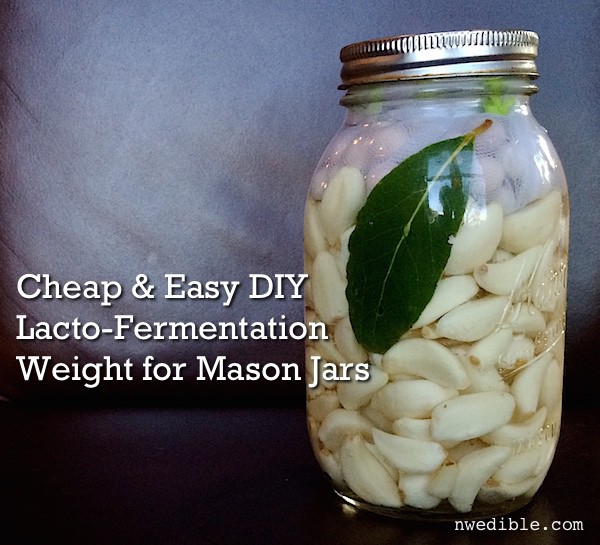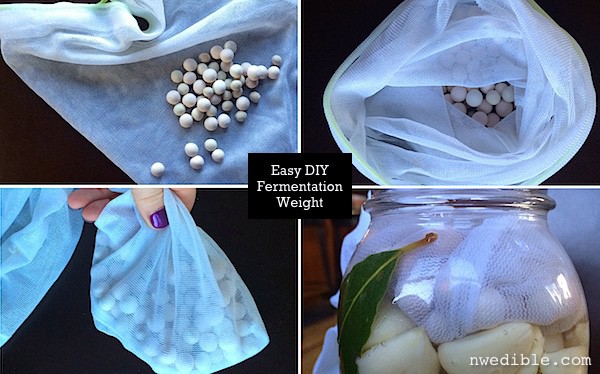There are three things to manage if you want the most successful lacto-fermented vegetables:
- Salt levels
- Fermentation temperature
- Oxygen exposure
When it comes to that third thing – oxygen exposure – the goal is none.
The Lactic Acid Bacteria that ferment veggies into tangy deliciousness are anaerobic. They do their best work far away from nasty corrosive oxygen.
I can’t blame them. Oxygen is a clingy, co-dependant a-hole. He’s constantly going around undermining everyone else’s cell integrity. That’s why antioxidants are such a big deal – they’re protection against the destructiveness of oxygen.

One time-tested and effective way to keep vegetables away from A-hole Oxygen (AO2?), is to weigh down the vegetables so that they are fully submerged under brine.
Sometimes this brine is added (like pickles) and sometimes it comes from the juices of the vegetables themselves (like sauerkraut).
Either way we have to press all the veggies completely under the brine and keep them submerged, or the stuff at the top that’s exposed to oxygen will be attacked by non-friendly bacteria and molds. Ack!
After much experimentation, I believe I have developed the ideal DIY lacto-fermentation weight for mason jar ferments. It’s re-usable, cheap, versatile and effective.
I knew from my success with brine-filled-plastic bags that the best weights for lacto fermented vegetables spread out to evenly weigh down the entire surface of the ferment. But that pesky plastic bag aspect bothered me.
After a few months of pondering my options for a reusable, durable, food safe way to weigh down my ferment, my mother downsized her kitchen gear and gifted me with her ceramic pie weights.
Some months later, an a ha! moment struck.
I could use mom’s pie weights to make a weight for my vegetable ferments!
Easy DIY Lacto-Fermentation Weight

I’l happy to say, after a few experimental versions, the pie weight fermentation experiment worked beautifully. I’m now enjoying tangy, spicy lacto-fermented pickled garlic.
You Will Need
- One small food safe polyester or similar mesh produce bag. (I used one of these, which I’ve had for years.)
- Clean ceramic pie weights. (The ones my mom gave me look similar to these.)
All pie weights should be food-safe, but after some research, I’d advise you look for unglazed pie weights that advertise themselves as non-porous or washable. If you are concerned about any leaching from the pie weights, there are also stainless steel pie weight chains available.
The mesh bag will probably be made out of food safe polyester or a similar poly-type resin. This is a kind of plastic.
It’s hard to get away from synthetics in this application. You need something flexible, that will move with the pie weights to fill up all the surface area of the ferment.
Experiments I tried with pie weights tied in cheesecloth and up-cycled cotton fabric didn’t work that well for me. These fabrics absorbed and wicked the brine up and away from the vegetables, got moldy, and had a tendency to float up a bit during the natural off-gassing of fermentation. If you are a strict no-plastic-ever person, but like this concept, please play around with natural fabrics. If you find something that works, please share!
Personally, I’m comfortable using low-reactivity food-safe plastic mesh in non-heated situations like this.
Whatever pie weights and bag you use for fermentation should be kept for just fermentation. Don’t take your garlic ferment pie weights and later put them against the crust for your lemon chiffon pie.

To Assemble The Fermentation Weight
This is pretty basic. Rinse the clean pie weights just in case they are dusty from storage, and put a handful of weights in the bag. Twirl the bag around to make a kind of seal.
That’s it.
When I say easy, I mean easy.
Use the fermentation weight to hold your lacto-fermented veggies well under the brine. Just pile any extra “tail” from the bag up on top of the jar like a tidy little turban, then screw a 2-piece mason jar lid onto your ferment just fingertip tight. Or, for extra insurance, screw on a DIY Mason Jar Fermenting Crock lid.
My Experience
I fermented my garlic under this weight for 16 days at cool room temperature.
On day 2 or 3 the huge puddle on my counter reminded my to set my jar on a sheetpan to make clean up easier. I used a standard 2-piece mason jar lid (no airlock this time), and saw very vigorous, effective fermentation. There was no mold, scum or other evidence of yeast or undesireable microbial growth.
When I was satisfied with the tang of my garlic and ready to transfer it to the fridge, I washed the pie weights by hand in a bowl of soapy water and rinsed well. I put them on a clean sheetpan and, because my oven was already preheated for something else, popped them in the oven for about 20 minutes to dry completely and sanitize. The mesh bag was washed in the washing machine and hung to dry, which is what I normally do.
It took more effort to type that last paragraph than it did to clean the components of the DIY Fermentation Weight, is what I’m saying.
This one’s a keeper.
56
Brilliant! Thanks for the tip, as usual interesting, resourceful and workable. I am so glad you are back! I hope you will keep us updated as your book progresses to market.
Thanks Christina. 🙂 The book is in the very capable hands of the layout folks now. My big part is over, and now we just wait. It should hit shelves this Fall. I’ll keep you posted!
Brilliant. I may try that. I have been using the small glass lids that come with weck fancy canning jars but you can’t buy them separately and the whole jar and lid is kind of expensive for as many lids as I need. They fit so perfectly in a wide mouth jar. I usually leave them in when I refrigerate the pickles so nothing ends up floating and growing mold.
If you like your lids, you can buy glass disks designed as fermentation weights too. I’ve never used them, but I bet something like this would be similar to the Weck lids.
Another thing that fits nicely in large wide-mouth jars are the regular mouth, 4 oz, jelly jars (http://www.freshpreservingstore.com/ball-4-oz-quilted-crystal-jelly-jars-set-of-12/shop/383220/). After I’ve filled up my jar with whatever it is I’m pickling, I stick the partly filled jelly jars on top so they fit under the larger jar’s fermentation lid. If the brine expands a lot when fermenting, it just fills up the little jar more, rather than exploding or overflowing the large jar.
This site offers the lids alone! $1.25 a piece!
http://mightynest.com/shop/healthy-kitchen/canning/glass-replacement-canning-lid
This is brilliant! I’ve been wholly unimpressed with the clever ways of keeping the food dunked. (The cabbage leaf pushed down on top is just plain lame.) I have two things to add.
1) Being a thrifty soul I immediately thought of the jars of marbles we keep on our pantry windowsill (because my wife’s great grandma did the same and it looked so pretty). I now suspect they may have had a more practical purpose for great grandma and the window happened to be a pretty place to keep it. Knowing what we know now, I’d hesitate to use anything but the clear ones (at least not without first testing for lead and other nasties by soaking them in vinegar). I imagine the cheapo smooshed marbles sold at the dollar store (and craft stores for s little more) for fake flower arrangements would work just as well.
2) I may be wrong on this one but I’ve heard that metal and fermentation don’t mix. (But haven’t tried it so I don’t have personal experience.) If so, the metal pie chain might not be a good idea.
Thanks Tim – good point about the stainless pie chains. People should do their research. My first version of this was utilizing those cheapo glass floral bead things! But mine were colored, and I wasn’t convinced they weren’t half lead and cadmium or something, so I was skeeved out.
I think glass marble-type things are a great alternative to the ceramic pie weights. I’d love to know if there’s a certified food safe version of marbles and those glass decorative beads.
There might be a solution to the marble safety issue in wine making marbles. I don’t make wine myself, but from what I understand, wine makers occasionally have to “top up” or remove head space at various stages during fermentation. There are various ways to do this, but one method involves adding food-safe glass marbles to the mix in order to raise the level of the wine in the container. You can get three pounds of these food-safe marbles (they say enough to displace 1 liter of liquid) from this site for around $15 which may be more cost effective than pie weights if you don’t already have anything on hand.
http://morewinemaking.com/products/glass-marbles-topping-3-lbs.html?gclid=CKXh08_5xsgCFRCCaQodmxgCEw
On the subject of steel in ferments….. 316 stainless steel is suitable for use in acidic and salty environments we see in ferments. This has been used in win making for decades and in lacto fermenting of items like kraut and also kombucha. Anything less than 316 grade stainless could rust and leach in to your ferments. Never use aluminum or copper as they will for sure ruin your cultures
I’d also add that I’ve had reasonable success with the little plastic single serving applesauce cups. I poke lots of holes in the bottom with a hot framing nail and it sits on the rim of the jar just like a lid. Slap on a ring and you’re good to go.
They’re tapered so the smaller pieces can sometimes float around and up precariously closer to the surface and they don’t hold up well to the larger heavier dishes in the sink so they often end up being single use.
If you want to move away from plastic, and are using a wide mouth mason jar, you can fill a 4-oz (teeny!) mason jar with brine, and it will drop right into the opening, too. Before the pie weight discovery, this was actually my preferred weight for mason jar ferments.
Well, I guess I should have read all the comments before posting this same idea up in reply to someone else. Here I was thinking I was the only one who’d thought of such a thing. I guess great minds think alike!
I recently found mason jar weights made for pickling. Cant remember where, but they were cheap, one piece and easily disinfected. I ferment 3 gallons ata time, so didnt save the site. Typical all about me mindset. Apologies.
Very very cool.
Well now I have something to look up when work gets boring today. WTH is a pie weight? Guessing they’re not used with apple pies…. 🙂
Not sure if anyone already mentioned it, but I am wondering if a fine/light linen might work in place of the plastic. I believe it’s much less absorbent than cotton. I’ve never fermented before though, so I’m not sure it would hold up. Anyone with experience? Thanks for sharing Erica 🙂
love this!
Aquarium glass should be inert too. Fishies are pretty sensitive to nasties in the water and I’d bet no one wants to risk losing an expensive fish collection.
I used small, clean river rocks the same way you use the pie weights. Worked great and I didn’t have to worry if it was made from “natural” ingredients.
Well, blow my mind why don’t you. I did not know about fermentation weights till this moment. I made, ate, and apparently survived my pickles made without weights. Something to consider this next season I suppose. Hah! I love learning cool new shiz.
The brilliant Phickle blog mentioned this awhile back, and she uses those reusable cotton tea bags (http://phickle.com/index.php/the-tools-of-submersion/). I tried it with muslin for cheesemaking and haven’t found it sucked much in the way of brine. She also mentions using boiled stones! There’s your ultimate free option.
Mark Campbell Ceramics (on Facebook) makes crocks and weights if you want to see if he has the right size for quart jars. Unless I’m going to do my big crock for sauerkraut (have not fermented yet) I won’t need a big one so I’m inclined to look for river rocks or clean stones to start out with. I have some of those muslin tea bags, should work. Pie weights aren’t cheap!
Hi there! I have been reading your blog forever, thank for for all of the great information. I thought I’d share my inexpensive weight that I use in my lacto-ferments. These work great in wide mouth masons as well as Fido jars. A few years ago I splurged on a Pickl It jar and it came with a glass disc to submerge veggies. I couldn’t buy it separately. But they look like a glass pot watcher. The little glass discs that you place in the bottom of a pot of water that rattle when your water is boiling. I bought one and they fit in any fermentation vessel I’ve used and are great. They are Glass, non-porous, easy to clean, and relatively inexpensive. You can find them at kitchen stores for about $2 a piece. I love them.
I love your site.All your great information and tips,
You’re a real no nonsense kinda girl … I like that
Simply and easy ..thanks
So much great info! I’ve yet to “ferment” anything but I’m ready to start…garlic first :). I’ve got lots of river rocks…could someone tell me how long I need to boil them and do I need to store them any special way before using them as weights? Thank you!
I have a set of eight or ten nesting glass mixing bowls from Williams Sonoma, and I recently discovered that the tiniest bowl fits into a regular-mouth jar. I’ve used it a couple times now, and it perfectly holds vegetables under the brine. And I haven’t tried it yet, but I’d guess that the next size up would fit inside a wide-mouth jar.
There are lots of great ideas in this post and the comments, but I think my custom designed glass fermentation weights that fit perfectly into wide mouth Mason jars are the best option!
https://masonjarlifestyle.com/product/glass-fermentation-weights-fermenting-wide-mouth-mason-jars/
Do you think these stainless steel balls would work:
https://www.craigballsales.com/1-4-304-stainless-steel-balls-100-pcs..html
304 will rust. A simple google search will let you find it for yourself
I have used a silicone rubber spatula for a weight in a standard mason jar. I used it to press the ferment down below the liquid. Just take the handle off the spatula, fill jar with your fermentables to just above the neck of the mason jar. Then press the rubber spatula in into place beneath the neck of the mason jar it hold like a cork. So easy and how many of them do you have in your drawer?
Thanks for saving me money on weights! I’m curious, though, are weights needed when using an airlock? Is there enough residual oxygen to cause spoilage? My beer seems to do just fine with just an airlock.
Looking forward to pickling some home grown red onions and hot peppers!
Hello Erica! Do you have an article published on your process of making lacto-fermented pickled garlic?
I don’t think so – but as I recall it was a 3% brine, peeled garlic, and a bay leaf for pretty. 🙂 Really basic.
This really is brilliant! Instead of pie weights, I’m going to try these: https://www.amazon.com/Glass-Accents-Crafting-Mixed-Color/dp/B00QMO6I2C/ref=pd_sbs_201_2?_encoding=UTF8&psc=1&refRID=F9D8GDRQTK6MFFHR96ZF I can get them at the local craft store, today….no waiting! I have to find the food safe mesh bags, however. I may be able to find them locally, as well. Thank you!
Ooops! No, the glass baubles are not a good idea, after all. I couldn’t see how to delete my comment, but after looking into it, they may contain a lead glazing on them. I hope that the pie weights do not have lead glazing. I found some at the local BB and Beyond.